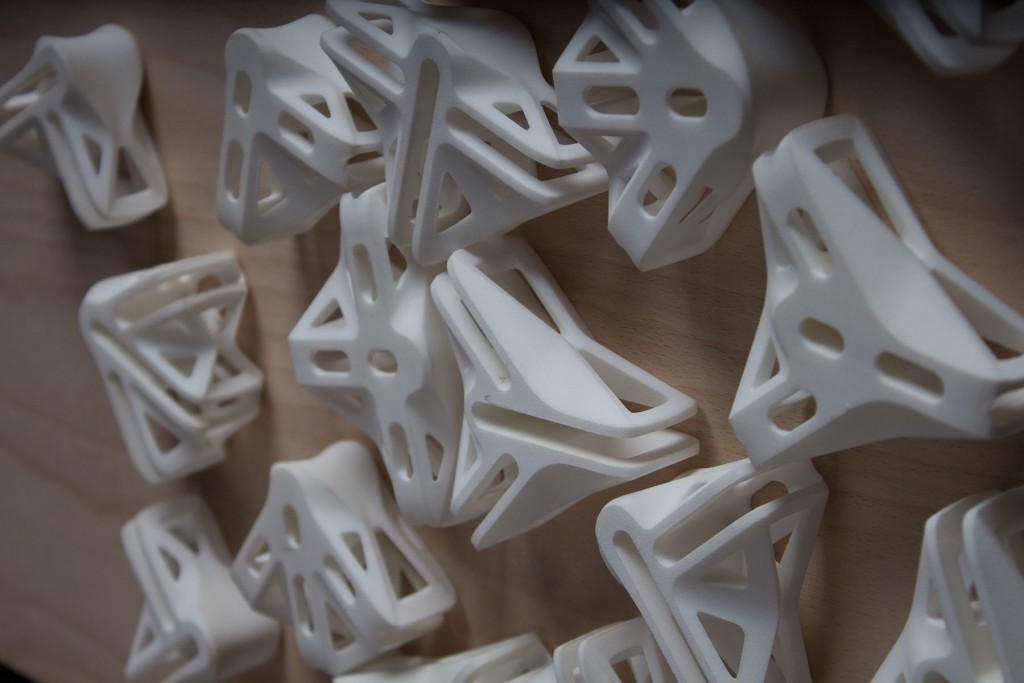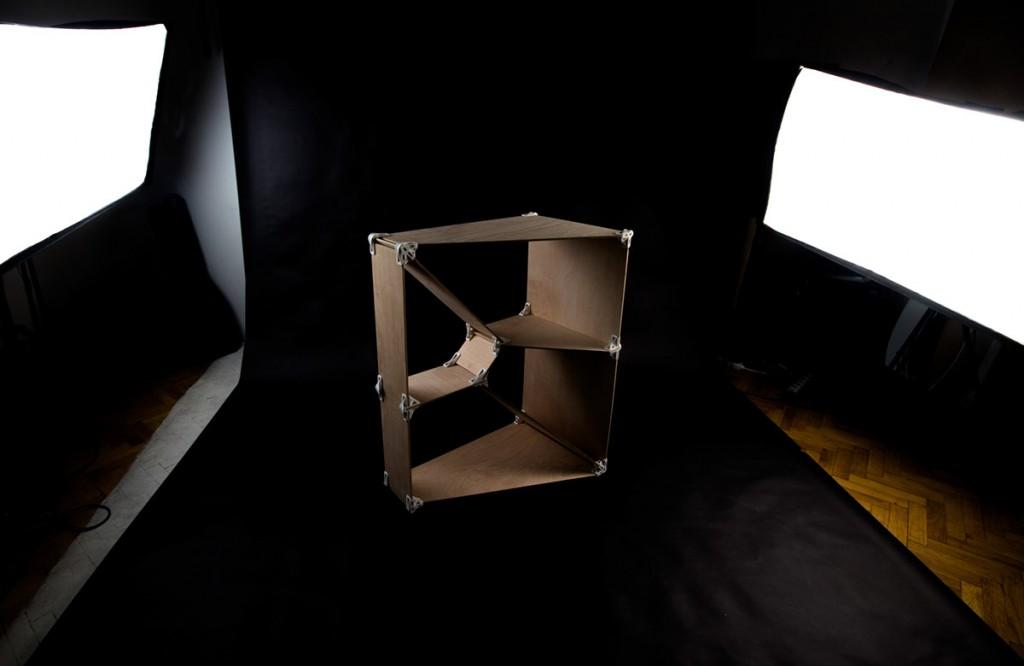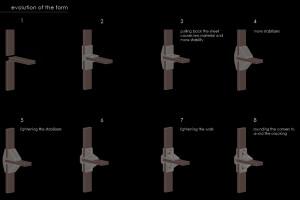People have been designing and producing 3D printable furniture for years now, to varying degrees of success. As you would expect, 3D printing with plastic isn’t always the best option for home furnishings. While there are large-scale 3D printers capable of producing full size pieces, they are not cheap and there is still the fragility of most 3D printing materials to consider.  Additionally, most desktop 3D printers have such a small printing envelope that any larger-scale furnishings would generally need to be either modular or printed in parts and assembled after the fact.
Additionally, most desktop 3D printers have such a small printing envelope that any larger-scale furnishings would generally need to be either modular or printed in parts and assembled after the fact.
So when Hungarian industrial design student Ollé Gellért was contemplating the best way to enable the average 3D printer owner to create their own furnishings he decided that instead of thinking outside the box, he would think inside the printing envelope. Gellért created a collection of small, 3D printable joint connectors that would hold together flat pieces of inexpensive, easy to source materials. His connectors were designed to securely hold together flat pieces of standard .3 inch plywood. These joint connectors enable strong and durable furnishings to be created in virtually any size, configuration or design that the user could dream up.
“The basic question driving my project is how we can make use desktop 3D printers as best as we can in our homes. This is a very current problem, because in the past the main focus was on rapid prototyping but in the future it is on rapid manufacturing. This is because the price of the FDM printers is decreasing greatly. One of the possible solutions is the joint design. If we want to create larger objects with our printers, we should print only the small joints and we will be able to connect bigger parts from different materials,” explained Gellért.
Gellért started by designing a few test parts in Rhino3D that would snugly hold together several pieces of plywood. After settling on a basic design that worked the best and held the wood together securely, he went on to refine the parts. First by reducing the amount of material the joints would require, and then by adjusting the design to improve stability. He ended up designing 25 individual joints that can connect up to three different pieces of wood at 45 degree, 90 degree or 120 degree angles. Additionally, they were designed so the final furnishings would require no glue or screws once assembled.
“One important feature of the design is that you do not have to screw or glue the parts. It is possible to build furniture, installations, partitions and anything else. It only depends on your creativity. With these experimental objects I wanted to draw attention to the importance of changing our thinking as to how to build something with 3D printers,” Gellért explained on his Behance project page.
The Print To Build joint connectors allow 3D printer owners to design just about any type of modular furniture that they can think of. With the proper placement of joints, Gellért says that when testing durability, the plywood actually cracked before the joints bent or slipped. He used the joints to design multiple variations of shelving units, and intricate scaffolding objects that while impractical are visually stunning. Gellért says that his joints can be used to build easy to move storage systems, complex exhibit installations, small-scale furnishings, benches and tables. And most likely configurations that he hasn’t even dreamed of yet.
While prototyping his Print To Build joint connectors, Gellért used a Stratasys Dimension FDM 3D printer using ABS material. His aim was to optimize the usability for the average 3D printer owner, so he designed the joint connectors to be usable even with the most inexpensive and common 3D printer technology. For his final class presentation, he printed the set of joint connectors on an SLS 3D printer; however, Gellért says that would be too expensive to produce enough connectors to be usable. He also found no real difference in the functionality or durability of the joints and says that they should work just as well when printed in ABS or even using PLA.
For now Gellért is selling his current iteration of Print To Build joint connectors over on Cults3D, where you can purchase the entire set of 3D files for less than $17, but he is far from done with the project. He also plans to design alternate sized connectors that can be used with flat slats of plywood of different thicknesses. Additionally, he is developing connectors that can be used with different materials like metal sheets and even glass. Presumably these joint connectors could even be mixed to allow furniture incorporating multiple materials.
What would you build with these joint connectors? How do you think these compare to another set of 3D printed furniture joints we saw last month? Let us know over on our Building Furniture with 3D Printed Joint Connectors forum at 3DPB.com.
————————–
Hungarian industrial design student Ollé Gellért created a set of 3D printable joint connectors that can hold together thin pieces of plywood. These connectors come in enough configurations to allow anyone to create complex and visually striking pieces of modular furniture. In addition to connectors that work with plywood, he is also developing alternate sets of connectors for different materials and thicknesses. You can read more over on 3DPrint.com: https://3dprint.com/83723/print-to-build-connectors/
Below is an example of furniture created with 3D printed joints and plywood:
https://3dprint.com/wp-content/uploads/2015/07/3dp_printtobuild_example.jpg
Subscribe to Our Email Newsletter
Stay up-to-date on all the latest news from the 3D printing industry and receive information and offers from third party vendors.
You May Also Like
Precision at the Microscale: UK Researchers Advance Medical Devices with BMF’s 3D Printing Tech
University of Nottingham researchers are using Boston Micro Fabrication‘s (BMF) 3D printing technology to develop medical devices that improve compatibility with human tissue. Funded by a UK grant, this project...
3D Printing Webinar and Event Roundup: April 21, 2024
It’s another busy week of webinars and events, starting with Hannover Messe in Germany and continuing with Metalcasting Congress, Chinaplas, TechBlick’s Innovation Festival, and more. Stratasys continues its advanced training...
3D Printing Webinar and Event Roundup: March 17, 2024
It’s another busy week of webinars and events, including SALMED 2024 and AM Forum in Berlin. Stratasys continues its in-person training and is offering two webinars, ASTM is holding a...
3D Printed Micro Antenna is 15% Smaller and 6X Lighter
Horizon Microtechnologies has achieved success in creating a high-frequency D-Band horn antenna through micro 3D printing. However, this achievement did not rely solely on 3D printing; it involved a combination...































